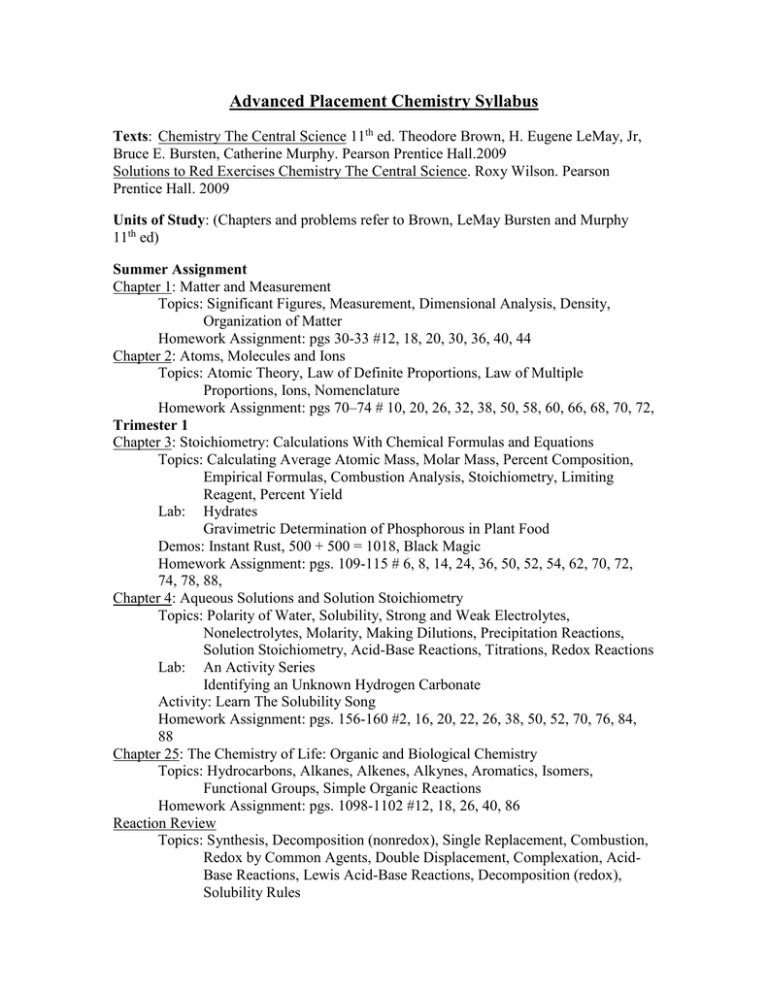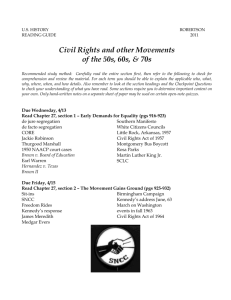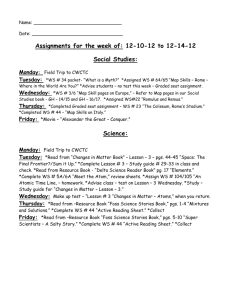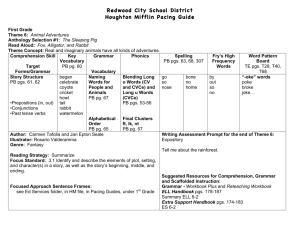
Advanced Placement Chemistry Syllabus
Texts: Chemistry The Central Science 11th ed. Theodore Brown, H. Eugene LeMay, Jr,
Bruce E. Bursten, Catherine Murphy. Pearson Prentice Hall.2009
Solutions to Red Exercises Chemistry The Central Science. Roxy Wilson. Pearson
Prentice Hall. 2009
Units of Study: (Chapters and problems refer to Brown, LeMay Bursten and Murphy
11th ed)
Summer Assignment
Chapter 1: Matter and Measurement
Topics: Significant Figures, Measurement, Dimensional Analysis, Density,
Organization of Matter
Homework Assignment: pgs 30-33 #12, 18, 20, 30, 36, 40, 44
Chapter 2: Atoms, Molecules and Ions
Topics: Atomic Theory, Law of Definite Proportions, Law of Multiple
Proportions, Ions, Nomenclature
Homework Assignment: pgs 70–74 # 10, 20, 26, 32, 38, 50, 58, 60, 66, 68, 70, 72,
Trimester 1
Chapter 3: Stoichiometry: Calculations With Chemical Formulas and Equations
Topics: Calculating Average Atomic Mass, Molar Mass, Percent Composition,
Empirical Formulas, Combustion Analysis, Stoichiometry, Limiting
Reagent, Percent Yield
Lab: Hydrates
Gravimetric Determination of Phosphorous in Plant Food
Demos: Instant Rust, 500 + 500 = 1018, Black Magic
Homework Assignment: pgs. 109-115 # 6, 8, 14, 24, 36, 50, 52, 54, 62, 70, 72,
74, 78, 88,
Chapter 4: Aqueous Solutions and Solution Stoichiometry
Topics: Polarity of Water, Solubility, Strong and Weak Electrolytes,
Nonelectrolytes, Molarity, Making Dilutions, Precipitation Reactions,
Solution Stoichiometry, Acid-Base Reactions, Titrations, Redox Reactions
Lab: An Activity Series
Identifying an Unknown Hydrogen Carbonate
Activity: Learn The Solubility Song
Homework Assignment: pgs. 156-160 #2, 16, 20, 22, 26, 38, 50, 52, 70, 76, 84,
88
Chapter 25: The Chemistry of Life: Organic and Biological Chemistry
Topics: Hydrocarbons, Alkanes, Alkenes, Alkynes, Aromatics, Isomers,
Functional Groups, Simple Organic Reactions
Homework Assignment: pgs. 1098-1102 #12, 18, 26, 40, 86
Reaction Review
Topics: Synthesis, Decomposition (nonredox), Single Replacement, Combustion,
Redox by Common Agents, Double Displacement, Complexation, AcidBase Reactions, Lewis Acid-Base Reactions, Decomposition (redox),
Solubility Rules
Homework Assignment: Weekly equation sets from old AP exams
Chapter 10: Gases
Topics: Pressure, Boyles’ Law, Charles’ Law, Avogadro’s Law, Combined Gas
Law, Gas Stoichiometry, Ideal Gas Law, Dalton’s Law, Kinetic Molecular
Theory, Real Gases vs. Ideal Gases
Labs: Molar Volume of a Gas
Molar Mass of a Volatile Liquid
Demos: Pop Your Top, Smelly Balloons, Shrinking Balloons, The White Ring,
Potato Gun, Vacuum Gun, Crushed Can, Egg in a Bottle, Vacuum Pump
Expansions
Homework Assignment: pgs 426-433 #1, 6, 9, 24, 26, 40, 50, 52, 54, 62, 68, 76,
82, 84, 106
Chapter 15: Chemical Equilibrium
Topics: Gas Equilibrium, Solution Equilibrium, Applications of K, Calculation of
Equilibrium Concentrations, LeChatelier’s Principle
Lab: Modeling Dynamic Equilibrium with Coins
Determination of Keq for FeSCN2+
Demos: Equilibrium Demo with Pennies, Oxides of Nitrogen Equilibrium Tubes,
Chemical Equilibria of Silver Ions
Homework Assignment: pgs. 658-662 #2, 3, 7, 8, 10, 16, 30, 32, 38, 40, 44, 52,
61
Chapter 16: Acids-Base Equilibria
Topics: Bronsted-Lowry Model, pH Scale, Weak Acids, Ka, Weak Bases, Kb,
acidity of Salt Solutions, Lewis Acids and Bases
Labs: Determination of the Equivalent Mass and pKa of an Unknown Acid
LeChatelier’s Principle
Demos: A Voice Activated Reaction, MOM to the Rescue, The Tortoise and the
Hare, Rainbow Tube, Velcro Acids and Bases, Hydrolysis of Salts,
Indicator Sponge
Video: World of Chemistry – The Proton in Chemistry
Homework Assignment: pgs. 709-715 #2, 4, 8, 18, 22, 28, 40, 46, 48, 52, 58, 62,
76, 78, 86, 94, 102
Trimester 2
Chapter 17: Additional Aspects of Aqueous Equilibria
Topics: Buffers, Acid-Base Titrations, Choice of Indicator, Solubility Equilibrium
Labs: Preparation and properties of buffer solutions
Indicators, pH and Titrations
Determining the Solubility Product Constant of Calcium Hydroxide
Demos: Now You See It Now You Don’t
Homework Assignment: pgs. 758-762 #3, 4, 5, 6, 9, 22, 28, 32, 36, 38, 42, 44, 50,
54, 56, 58, 64, 68
Chapter 14: Chemical Kinetics
Topics: Reaction Rate, Order of Reaction, Rate Laws, Activation Energy,
Reaction Mechanisms, Catalysts
Lab: Flipping Pennies and Burning Candles
Kinetics of a Reaction
Kinetics of the Fading of Phenolphthalein in Alkaline Solution
Demos: Dragon Breath, Elephant Toothpaste, Plop, Plop Fizz Fizz, Funneling
Ahead, Paper Clip Catalyst
Videos: Weird Weird Science – Grain Elevator Explosion, Oscillating Clock
Reaction; Heath Kinetics - #32 – 35
Activity: Game - Depletion
Homework Assignment: pgs. 615-622 #2, 3, 5, 7, 9, 22, 26, 30, 32, 36, 40, 52, 56,
64, 66, 68, 74
Chapter 5: Thermochemistry
Topics: First Law of Thermodynamics, Enthalpy, Calorimetry, Hess’s Law,
Standard Heats of Formation
Lab: Specific Heat of a Metal
Determining the Enthalpy of a Chemical Reaction
Demos: Boiling water in a paper cup, freezing flask to wood block, burning
magnesium
Homework Assignments: pgs. 202-206 #7, 8, 10, 26, 42, 44, 48, 52, 54, 56, 62,
64, 70, 74
Chapter 19: Chemical thermodynamics
Topics: State Functions, Spontaneous Reactions, Entropy, Gibbs Free Energy,
Relationship between Free Energy and Equilibrium
Videos: Heath #4-8
Homework Assignment: pgs. 833-839 #2, 3, 6, 14, 42, 50, 52, 54, 64, 66, 76, 78,
80
Chapter 20: Electrochemistry
Topics: Salt Bridge Cell, Standard Voltages, Strengths of Oxidizing and Reducing
Agents, Relationship Between E, ΔG, and K, Nernst Equation, Electrolytic
Cells, Commercial Cells
Labs: Electrochemical Cells
Determination of Iron Content by Redox Titration
Demos: The Can Ripper, The O.J. Clock, Hot Dog Salt Bridge
Videos: Heath #25-27, 44, 46; Pickle Light, World of Chemistry – The Busy
Electron
Homework Assignment: pgs. 883-889 #3, 5, 6, 22, 34, 36, 42, 46, 52, 54, 60, 64,
88
Electrochemical Logic Puzzle
Chapter 6: Electronic Strutcure or Atoms
Topics: Electromagnetic Spectrum, Bohr Model, Quantum Numbers, Electron
Configurations
Lab: Atomic Spectroscopy
Planet Xeno Lab
Demo’s: The Atom Dazer, Energy Stored in a Crystal
Homework Assignment: pgs. 247-250 #12, 14, 22, 36, 42, 64, 66, 68
Quantum Theory Challenge
Chapter 7: Periodic Properties of the Elements
Topics: Effective Nuclear Charge, Sizes of Atoms and Ions, Ionization energy,
Electron Affinity
Homework Assignment: 290-292 #24, 28, 42, 50, 52, 60, 66
Trimester 3
Chapter 8: Basic Concepts of Chemical Bonding
Topics: Ionic Bonding, Lattice Energy, Covalent Bonding, Bond Energy, Lewis
Structures, Formal Charge, VSEPR Theory, Molecular Geometry, Polarity
Lab: Molecular Shapes and Structures
Demo’s The Suspended Paper Clip, The Great Marble Race
Homework Assignment: pgs. 333-336 #4, 12, 24, 40, 46, 52, 54, 62, 66
Chapter 9: Molecular Geometry and Bonding Theories
Topics: Valence Bond Theory, Hybridization, Sigma and Pi Bonds
Homework Assignment: pgs. 383-387 #2, 8, 36, 48, 52, 56, 58
Chapter 11: Intermolecular Forces, Liquids, and Solids
Topics: Intermolecular Forces, Phase Diagrams
Labs: Evaporation and Intermolecular Attractions
Liquid Chromatography
Homework Assignment: pgs. 471-476 # 2, 5, 6, 16, 26, 32, 34, 48, 54, 56, 72, 74
Chapter 21: Nuclear Chemistry
Topics: Band of Stability, Alpha, Beta, and Gamma Particles, Fission, Fusion,
Mass Defect and Binding Energy, Half Life, Nuclear Reaction
Activity: Game – Nucleogenesis
Homework Assignment: pgs. 925-929 #8, 18, 28, 34, 44, 77
Lab: 14 Test Tube Lab
Chapter 13: Properties of Solutions
Topics: Concentration Units, Colligative Properties: Boiling Point Elevation,
Freezing Point Depression, Osmosis, Vapor Pressure; Colligative
Properties in Electrolytic solutions
Labs: Using Freezing Point Depression to Find Molecular Weight
Demo: Is It Full?, Instant Slush
Homework Assignment: pgs. 563-568 #2, 7, 10, 16, 20, 24, 26, 30, 32, 44, 58, 62,
70, 76
Colligative Logic Puzzle
Review and Practice for AP Exam
Project preparation for Family Science Fun Night
Grading: Term grading is calculated as a ratio of total points scored out of total possible
points. Tests will generally be worth 100 points, labs and quizzes 20-30 points and
problem sets 10-20 points.
Tests: Tests are compiled from old released AP questions and are given covering two
chapters at a time. In between, take-home quizzes are given. Extra test points on the
multiple choice section are awarded for showing corrections to wrong answers. Half of
the missed points can be regained.
Laboratory: We have 5 periods per week of 62 minutes in duration. There is no double
lab period but our longer classes make up for this. Class is also scheduled to back up to
our “seminar” period and students may stay during that time to complete labs if
necessary. Labs are predominantly of the “wet lab” variety.
Students write up most labs in a bound lab notebook which is collected and
graded one week after the lab is performed. Students work in pairs to complete the
laboratory experiment but complete the lab write up independently.
Homework: Depending on the assignment and the personality of the class, homework
assignments may be assigned as problem sets to be completed over a period of time or
they may be assigned nightly. Reaction sets are assigned each week.






